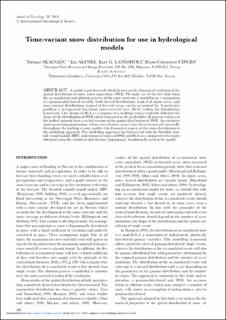| dc.description.abstract | A model is put forward which focuses on the dynamical evolution of the spatial distribution of snow water equivalent (SWE). We make use of the fact that when the accumulation and ablation process of the snow reservoir is modelled as a summation of a gamma-distributed variable, both skewed distributions, typical of alpine areas, and more normal distributions, typical of forested areas, can be accounted for. A particular
problem is to represent fractional snow-covered area (SCA) within the distribution framework. The change in SCA as a response to a melting event is explicitly linked to the shape of the distribution of SWE and is estimated as the probability of non-exceedance of the melted amount from a scaled version of the spatial distribution of SWE. An extensive snow-measuring programme, where several snow courses have been measured repeatedly throughout the melting season, justifies the dynamical aspects of the snow distribution in the modelling approach. The modelling approach has been tested with the Swedish rainfall-runoff model, HBV, and estimated values of SWE and SCA are compared with results obtained using the statistical distribution (log-normal) traditionally used in the model. | en_US |
